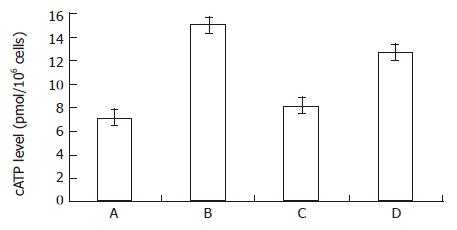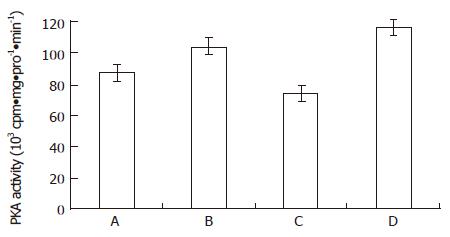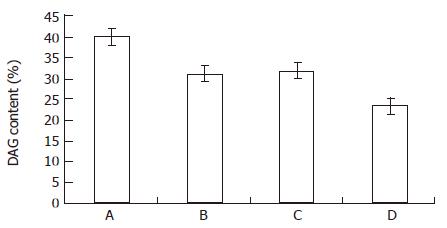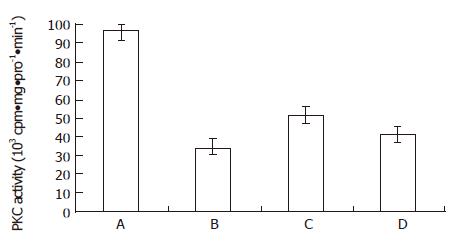Copyright
©The Author(s) 1997.
World J Gastroenterol. Mar 15, 1997; 3(1): 50-53
Published online Mar 15, 1997. doi: 10.3748/wjg.v3.i1.50
Published online Mar 15, 1997. doi: 10.3748/wjg.v3.i1.50
Figure 1 Changes of cAMP level in MGc80-3 cells treated in different conditions.
A: control; B: 1.8 g/L bailong; C: 1.8 g/L bailong + 20 mg/L PKA inhibitor; D: 5 mmol/L PKC inhibitor (n = 3)
Figure 2 Changes of PKA activity in MGc80-3 cells treated in different conditions.
A: control; B: 1.8 g/L bailong; C: 1.8 g/L bailing + 20 mg/L PKA inhibitor; D: 5 mmol/L PKC inhibitor (n = 3)
Figure 3 Changes of DAG activity in MGc80-3 cells treated in different conditions.
A: control; B: 1.8 mg/L bailong; C: 1.8 g/L bailing + 20 mg/L PKA inhibitor; D: 5 mmol/L (n = 3)
Figure 4 Changes of PKC activity in MGc80-3 cells treated in different conditions.
A: control; B: 1.8 g/L bailong; C: 1.8 g/L bailing + 20 mg/L PKA inhibitor; D: 5 mmol/L PKC inhibitor (n = 3)
- Citation: Gu SQ, Liang YY, Fan LR, Li BY, Wang DS. Co-regulative effects of the cAMP/PKA and DAG/PKC signal pathways on human gastric cancer cells during differentiation induced by traditional Chinese medicines. World J Gastroenterol 1997; 3(1): 50-53
- URL: https://www.wjgnet.com/1007-9327/full/v3/i1/50.htm
- DOI: https://dx.doi.org/10.3748/wjg.v3.i1.50
















